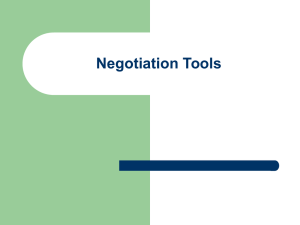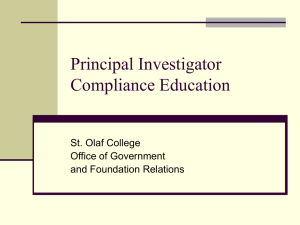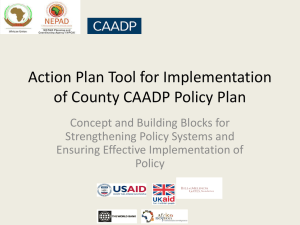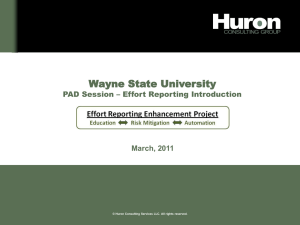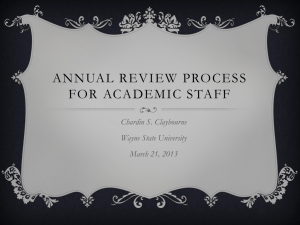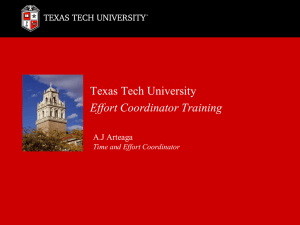Commitments - Research and Sponsored Programs
advertisement
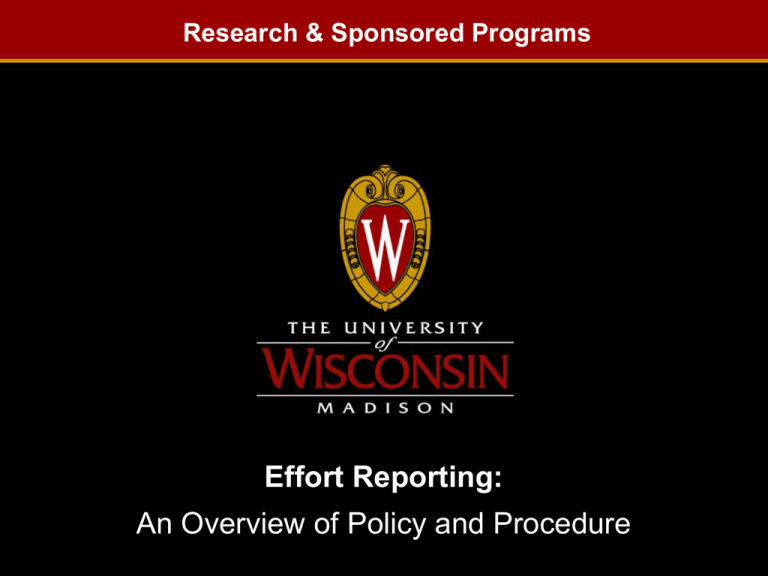
Research & Sponsored Programs Effort Reporting: An Overview of Policy and Procedure Agenda • Background: What is Effort Reporting? • UW-Madison Effort Policy • Key concepts • How to certify: The ECRT system • Special circumstances • Resources Slide 2 Handouts and Resources Resources: • Effort homepage: www.rsp.wisc.edu/effort/index.html – UW-Madison Guidelines for Effort Reporting (https://www.rsp.wisc.edu/effort/ectraining/GuidelinesForEffortReporting.pdf) – UW-Madison Effort Coordinator’s Guide to Certification Practices and Procedures (https://www.rsp.wisc.edu/effort/ectraining/ECGuide.pdf) • Handouts Slide 3 Background: What is Effort Reporting What is Effort Reporting? – Assuring an individual met his or her commitments • The sponsor got what it paid for – Assuring sufficient effort was devoted to justify salary charges • The sponsor paid for what it got Basically, an Effort Report is… a receipt. Slide 4 Background: What is Effort Reporting The basic idea • In a grant proposal, we offer effort • At award time, we make a commitment of effort • Throughout the project, we charge salary to the sponsor • Periodically, sponsors want to know: – Have we devoted enough effort to justify the salary charges? – Even in cases where we are not charging salary to the sponsor, have we fulfilled our commitments? • Precision is not required: Reasonable estimates are expected Slide 5 Background: What is Effort Reporting Authority • As recipients of federal funding, educational institutions must abide by OMB Circular A-21 (Cost Principles for Educational Institutions) • A-21, Section J.10 outlines acceptable methods for supporting charges related to “compensation for personal services” on federal grants and contracts – OMB A-21, J.10: “the reports will be signed by the employee, PI or responsible official(s) using suitable means of verification that the work was performed” – Direct knowledge not needed – First hand supervision not needed Slide 6 Background: What is Effort Reporting Use of Effort Reports Background: What is Effort Reporting Government Use: Institution Use: •Verify that labor charges are appropriate based on the amount of work performed • Management reporting tools •Verify that effort commitments and cost sharing is performed as promised •Verify that sponsored research is appropriately classified (i.e., included in Organized Research F&A base) Slide 7 • Are faculty and others working in areas as expected or promised? • Is payroll distribution appropriate? • Where is labor cost sharing occurring? • May be used for other reporting purposes (state teaching requirements, Medicare time reporting) Background: What is Effort Reporting Who certifies? • Certification is required for individuals who have paid or committed effort on sponsored projects • Effort must be certified by a person who has “suitable means of verifying” that the work was performed – Faculty, academic staff, and all PIs certify their own effort – PIs certify for graduate students, postdocs, and non-PI classified staff who work on their projects Slide 8 Background: What is Effort Reporting What the regulations require us to do… • Be careful about what we offer in a proposal • Be careful when making commitments at award time • Change commitments when needed, and document the changes • Fulfill commitments • Charge salary in a way that’s congruent with actual effort • Certify effort in a way that’s congruent with what actually happened Slide 9 Background: What is Effort Reporting What the regulations require us to do… • Not charge a grant for time that doesn’t pertain to the grant • Not charge a grant for time spent writing a proposal for a new project or a competing continuation – Time spent on these activities must be covered by institutional or gift funds • Transfer salary charges off of a grant if the level of effort does not justify the salary charges Slide 10 Background: What is Effort Reporting …And why we do it right. • The consequences of not getting this right can be dire for the university • Effort reporting remains a target for federal auditors • Many universities have paid millions of dollars in fines • Audits are underway at peer research institutions Slide 11 Background: What is Effort Reporting Lifecycle of a Grant PROPOSAL: Commitments are Offered AWARD: Commitments Become Obligations Commitment Setup Commitments are Fulfilled Tracking and Management Documentation & Reporting of Fulfillment Slide 12 UW-Madison Effort Policy: Who, What, When, Where, and Why Who: Whose Effort must be certified? • Effort must be certified for all UW faculty, staff, students, and postdoctoral researchers who either: – Charge part or all of their salary directly to a sponsored project, or – Expend committed effort on a sponsored project, even though no part of their salary is charged to the project Slide 13 UW-Madison Effort Policy: Who, What, When, Where, and Why Who certifies? • Effort must be certified by a responsible person with suitable means of verifying that the work was performed • At the UW: – All PIs, faculty, and academic staff members certify for themselves – PIs certify for the graduate students, postdocs, and non-PI classified staff who work on their projects • When the PI doesn't have suitable means of verifying that the work was performed: – A designee can certify the effort for project staff • When a staff person works on projects for multiple PIs: – Any one PI with suitable means of verifying all the effort can certify or… – Individual PIs can each certify part of the effort Slide 14 UW-Madison Effort Policy: Who, What, When, Where, and Why What is required? • Effort certification and effort training are mandatory • Penalties for non-compliance: The UW will not provide support for extramural activities • Precision is not required in certifying effort – Reasonable estimates are expected Slide 15 UW-Madison Effort Policy: Who, What, When, Where, and Why What is required? • Recertification—up to the certification deadline, you can grant a request to recertify, and you can reopen the statement for recertification • After the certification deadline: – The PI must submit a written request to RSP – The written request will be reviewed by the Associate Vice Chancellor for Research Administration – Only in the most compelling of circumstances will it be granted Slide 16 UW-Madison Effort Policy: Who, What, When, Where, and Why When to certify and take training: • For classified staff: 4 times / year – Periods of performance (PPs) correspond to calendar quarters • For faculty, academic staff, grad students, and postdocs: twice yearly – PPs are January - June and July - December • Certification starts a month or more after the PP • The certification window is 90 days • The schedule may be altered during the transition to ECRT • Training is required just once—it does not need to be repeated – Training must be done within 90 days of the date on which the person’s first effort statement is available for certification in ECRT (see p. 14 in the Effort Guide) – Training takes 30-40 minutes to complete Slide 17 UW-Madison Effort Policy: Who, What, When, Where, and Why Where to certify: ECRT • An electronic system where individuals certify their effort and where ECs process effort cards • Produced and managed by Huron Consulting Slide 18 UW-Madison Effort Policy: Who, What, When, Where, and Why Why is there an Effort Coordinator (EC) role? What does the EC do? • Review each certification • Initiate any follow-up actions, if necessary (including salary cost transfers, to make payroll congruent with effort) • Document the reasons for any differences between pre-printed effort numbers and certified effort percentages • Approve (or process) each correct certification • Assist certifiers • Keep tabs on who has and hasn’t certified, and nudge delinquents in the right direction Slide 19 UW-Madison Effort Policy: Who, What, When, Where, and Why Why is there an Effort Coordinator (EC) role? What does the EC do? • Four key questions ECs must ask for every card before processing: – What is the effort commitment? – What actually happened? – What were the salary charges? – How much effort was certified in ECRT? • Tools are available to help with ECs monitor and manage effort certification • Help and information are available – Effort Guidance document – EC Guide – Online resources – Handouts Slide 20 Key Concepts Lifecycle of a Grant PROPOSAL: Commitments are Offered AWARD: Commitments Become Obligations Commitment Setup Commitments are Fulfilled Tracking and Management Documentation & Reporting of Fulfillment Slide 21 Key Concepts Slide 22 Key Concepts: Commitments • A statement in the proposal or project application – Specific and quantified – Effort for a PI, co-investigator, or key person, regardless of whether salary is charged • An obligation that the university must fulfill • Example – Professor Jones proposes 30% of her effort for 12 months and requests 10% salary support: – Professor Jones has committed 30% of her effort for that 12-month period Slide 23 Key Concepts: Commitments Commitments Effort Paid Effort Non-Effort Cost-Shared Effort Non-Payroll Cost Sharing Not Paid By Sponsor Slide 24 Key Concepts: Commitments Minimum commitment required; Changing commitments • Minimum commitment: The PI/PD's minimum required commitment to each project is 1% effort, • Exceptions to minimum commitment rule: – When an individual is the PI on multiple clinical trials • The commitment to any one trial may be less than 1%, as long as the sum of all the commitments represents a reasonable level of effort – Equipment and instrumentation grants, doctoral dissertation grants, and student augmentation grants • Commitments can be changed – Some changes require prior written approval from the sponsor – All other changes must be documented – A note in the department administrator’s project file – An email exchange – A note in the ECRT system Slide 25 Key Concepts: Commitments Rebudgeting vs. Changing the level of committed effort: • PIs generally have some flexibility in managing project budgets, including salary charges • However, rebudgeting authority does not confer the right to: – Make significant changes in work activity without prior approval – Change effort commitments without documenting the changes • Rules for changing salary and effort are summarized on the RSP Web site Slide 26 Key Concepts: Commitments For whom are commitments required? • The principal investigator/project director • All co-investigators • All individuals identified as senior/key personnel in the grant proposal – Slide 27 When the proposal does not explicitly list key persons, the university defines key personnel for the purpose of effort reporting as the principal investigator/project director and all co-investigators Key Concepts: Commitments Where are commitments indicated? • Some statements in the proposal become commitments when the university and the sponsor finalize the award agreement: – Requests for salary support and statements about cost-shared effort in the budget or budget justification – Effort proposed in the research plan or project description – but only when specific and quantified: • Slide 28 Example: "Professor Jones will devote 10% of his time during the academic year to this project." Key Concepts: Commitments Limits on total commitments • Commitments can never total more than 100% • Commitments to sponsored projects can add up to a full 100% only if ALL of your UW job duties can be allocated to sponsored projects – This is generally not the case for faculty members, for any consecutive 12month period • Can academic staff, postdocs, classified staff be paid 100% from sponsored projects? – This is not against the rules, and it’s entirely appropriate in many, but not all, circumstances Slide 29 Key Concepts: Commitments When the awarded budget is less than proposed • You cannot assume that the effort commitments are automatically reduced in proportion to the budget reduction • You have several options: – Keep salaries and effort the same, and reduce other budget categories – Keep effort the same, reduce salaries, and document the increase in cost sharing – Reduce effort commitments – requesting prior approval for a key person's reduction of 25% or more Slide 30 Key Concepts: Effort What is Effort? • Effort is not based on a 40-hour work week • 100% equals all the activities for which you are compensated by the UW, regardless of the appointment percent or number of hours worked • Examples: – If you work a half-time job, your 100% = what you do for that 0.5 FTE appointment – If you work 80 hours a week, your 100% = what you do during those 80 hours Slide 31 Key Concepts: Effort What counts as Effort? • The activities for which you are compensated by the UW • This includes: – Externally sponsored research – Internally-funded or unfunded research – Instruction, administration, and service on committees – Public service and outreach activities directly related to your UW professional duties Slide 32 Key Concepts: Effort UW Institutional Base Salary (IBS) • IBS Includes salary from these sources • Extramural grants, contracts, cooperative agreements from federal and nonfederal sponsors, UW hospital affiliation agreements, gifts, Federal formula Hatch funding, intramural grants, startup, retention, FFS, F&A return, endowment, State of WI GPR, extension funds, WARF funds • Regular Salary, Summer Salary, Regular Wages, Overtime for hourly, Sabbatical, Paid professional leave • IBS Excludes salary from these sources • UW Med Foundation Clinical Practice Plan (paid directly to an individual by the UWMF), VA Med Center, WARF royalties (paid directly to an individual), Outside professional work (consulting, peer review, etc..) • Bonus payments, temporary supplements, tuition remission, lump-sum payments Slide 33 Key Concepts: Effort What does not count as Effort? • Activities for which someone else compensates you, and some activities for which you are not paid • Examples: – Consulting – Leadership in professional societies – Peer review of manuscripts – Advisory activities for a sponsor (NIH study section, or NSF peer review panel) – Clinical activity funded by the UWMF – Activity for a VA appointment Slide 34 Key Concepts: Effort What counts as sponsored activity? • Activities contributing to and intimately related to work under the agreement • As long as it's about the specific project, it counts as sponsored activity: • – Lab meetings, conferences, seminars, writing a progress report – Reading journals to keep up-to-date on subject area Writing a proposal for a new project or competing continuation does NOT count – An issue for some people who are funded 100% on sponsored projects! • Lab meetings not specific to a project do NOT count • Research patient care – The care that is described in the protocol is sponsored activity – Routine patient care is NOT, even if provided to a research subject Slide 35 Key Concepts: Effort Effort that is too small to count: • Activities that you do on an infrequent, irregular basis can be ignored in your effort calculations if the total amount of time would not affect your effort distribution – • Some activities should not be counted as separate from your UW job duties, such as: – – • • Possible examples: department meetings, serving on a search committee – depending on your individual situation Requesting your parking assignment Completing a travel expense report Regular, well-defined activities generally should not be treated as de minimis Proposal writing cannot be de minimis Slide 36 Key Concepts: Effort Unfunded or “weekend” work: • Activities that are closely associated with your UW professional duties must be reported as UW effort • Examples: • – Proposal writing – Instruction, administration, service on committees You cannot characterize them as "unfunded" or "volunteer" activities, or "weekend work," for which no UW salary is paid Slide 37 Key Concepts: Effort Effort can vary over time: • To meet a commitment, the actual effort need not be a constant • It must add up, over time, to fulfill the commitment • Example: If 30% effort is committed for a calendar year, one way to fulfill this commitment is by spending: – 40% effort on the project during the first six months of the year, and – 20% effort on the project during the last six months Slide 38 Key Concepts: Effort Changes in Effort: • A significant change in work activity is: – A 25 %(or greater) reduction in the level of committed effort – An absence from the project of three months or more – A withdrawal from the project • For a PI/PD or key person as listed in the NOGA: – A significant change in work activity requires prior approval in writing from the sponsor's Grants Officer • Example: – The PI's committed effort is 40%. PI wants to reduce committed effort to 30% – The reduction is 25% of the original effort commitment, so it requires prior written approval • Other commitment changes must be documented: – Any other change, for a person listed in the NOGA – ANY change, for a key person listed in the proposal but not in the NOGA Key Concepts: Effort Case Study – calculating effort: •Ron Burgandy is a 9 month faculty who is paid $140,000/year. Ron is awarded a grant from 7/1/12-12/8/12. His budget calls for him to be paid $20,000. What is his effort commitment? 1.Determine calendar months – $140,000/9 months = $15,555 monthly – Payroll yearly/monthly = $20,000/$15,555 = 1.3 salary months 2.Determine dates – 8 days in Dec = (8/31) = .26 months – + 5 full months from Jul-Dec = 5.26 project months 3.Calculate effort – 1.3 salary months/5.26 project months = 25% effort Slide 40 Key Concepts: Cost Share What is Cost Share? • Cost sharing is the portion of the total costs of a sponsored project that is borne by the UW • Cost-shared effort is any work on a sponsored project for which the university, rather than the sponsor, provides salary support • Paid effort is work for which the sponsor provides salary support • Example – With a 30% effort commitment and salary support for 10% of the effort: – 10% is paid effort – 20% is cost-shared effort Slide 41 Key Concepts: Cost Share Mandatory Cost Share vs. Voluntary Committed Cost Share: • Mandatory cost sharing is cost sharing that’s required by the sponsor as a condition for proposal submission and award acceptance – This is reflected on your statement • Voluntary committed cost sharing is cost sharing that is not required as a condition for proposal submission – But, once offered and accepted, it becomes a commitment – Currently, this is NOT reflected in the numbers you see when you log in – However, it must be certified; we’ll show you how Slide 42 Key Concepts: Cost Share IMPORTANT: Cost sharing should be limited only to those situations where: 1.It is mandated by a sponsor, or 2.The University has determined that such a contribution is critical to ensure the success of a competitive award or proposal, or 3.It is necessary to fulfill the University’s requirement of a minimum commitment to the project by the principal investigator or project director. Where cost sharing is not required by the sponsor, necessary to ensure the competitiveness of a proposal, or required as a minimum commitment to the project, PIs and departments or centers/schools should refrain from making such commitments voluntarily. In all situations, the use of cost sharing should be kept to a reasonable level because of the burden that it places on University and departmental resources. Slide 43 Key Concepts: Cost Share Voluntary Uncommitted Cost Share: • When you certify, you must include cost-shared effort up to and including the amount of your cost-sharing commitments • If you’ve put in more time than you were paid to spend, over and above your cost-sharing commitments: – This is voluntary uncommitted cost sharing – This extra effort is not required to be documented or tracked – You should not include it in the effort you certify for a sponsored project Slide 44 Key Concepts: Salary Cost Transfers (SCTs) • If a salary cost transfer was initiated prior to certification: – Researchers should not wait for it to post before certifying effort • As a result of certification, a salary cost transfer can be initiated to bring payroll into line with certified effort – This is an appropriate and important part of sponsored projects administration • Effort certification guidelines do not change the existing salary cost transfer policy Slide 45 Key Concepts: DHHS Salary Cap • See handout 6 Slide 46 How to Certify Time Periods: • Period of performance – The semiannual or quarterly time period for which effort must be certified • Certification period (or certification window) – The time during which: • Faculty and staff certify effort • You review and process the certifications Slide 47 How to Certify • The ECRT web page on which certifiers: – View the payroll distribution and cost-sharing amounts – Enter and certify the effort distribution • Once certified, this becomes an official university document and is subject to audit How to Certify Sponsored and non-sponsored pay sources: • For the purpose of effort certification, sponsored effort includes: – Fund 133 – Non-Federal Projects (except gifts) – Fund 142 – Hatch Adams - Land Grant Research – Fund 143 – Smith Lever - Land Grant Extension – Fund 144 – Federal Projects • Non-sponsored pay sources are: everything else Slide 49 How to Certify The certifier’s primary department: • Based on information in the UW HR/Appointment system • Determines which effort coordinator will process the statement • For people with multiple appointments: – A true "primary department" can't always be determined from HR data – The ECRT primary department may not be correct and can be changed within ECRT Slide 50 How to Certify Where does the EC fit? Academic Staff Certifiers Dean’s Office Faculty Certifiers Effort Coordinator Department HR Coordinator RSP Department Research Administrator Department Payroll Coordinator • If a department has more than one effort coordinator – Only the primary EC can process the effort statements – The secondary can view statements and reports, enter notes, and assist certifiers but cannot process a statement How to Certify Current vs. historical effort: • Based on information in the UW HR/Appointment system • Determines which effort coordinator will process the statement • For people with multiple appointments: – A true "primary department" can't always be determined from HR data – The ECRT primary department may not be correct and can be changed within ECRT Slide 52 How to Certify Phases of Effort Statement Under Construction Ready for Certification Returned Reopened for Recertification Slide 53 Certified Processed How to Certify Salary charges must be consistent with actual effort: • When you devote 40% effort for six months and 20% for six months, it is not acceptable to: – Charge salary at a constant 30% rate, or – Certify effort at a constant 30% rate • But a short-term fluctuation is acceptable: – An effort deficit of not more than two months, with… – Catch-up in a comparable period, such that it all evens out Slide 54 How to Certify Degree of tolerance (aka “5% rule”): • There is an acceptable variance between your actual effort and the effort as certified on the statement • The UW defines this to be: five percentage points out of your 100% UW effort (aka “5% rule”) • Example: – – – • The 5% rule does NOT mean that you can certify 100% of your effort on sponsored projects – • Effort statement shows 50% of salary was paid by the sponsored project No cost sharing It is permissible to certify 50% effort on the project if actual effort on the project could reasonably be determined to fall between 45% and 55% of total UW effort It only describes a degree of tolerance for a single project You cannot charge salary to the sponsor for activities that are not allocable to sponsored projects! Slide 55 How to Certify Certifying effort over a 6-month period: Activity DOD Award A NIH Award B NSF Award C Average 25% 20% 21% Jan 50% 30% 5% Feb 50% 30% 5% Mar 50% 30% 5% Apr 0% 20% 5% May 0% 10% 5% • Use the Effort Calculator that’s available from within ECRT – Check the “Add-on Tools” link Slide 56 Jun 0% 0% 100% How to Certify 9-month appointments: • If you have a 9-month appointment and don’t receive summer salary, your effort periods are effectively: – January through May (a 5-month period) – September through December (a 4-month period) • If you receive summer salary, each month of summer salary adds a month back to the corresponding period of performance • Example – If you receive summer salary for June only, calculate: – Spring effort levels as percentages of 6 months – Fall effort levels as percentages of 4 months Slide 57 How to Certify Example 1: Certifies to payroll How to Certify Example 2: Effort is promised, and no salary is charged How to Certify Example 3: Implied promise of effort How to Certify Example 4: No commitment (45 or 46) Effort Reporting: Special Circumstances • Grad students, postdocs, and non-PI classified staff who work on multiple sponsored projects for different PIs: – Who certifies their effort? See the Effort Coordinator’s Guide, page 78 (Handout 14) • People with appointments in multiple departments: – Is there more than one effort statement? Which effort coordinator processes the certification? See the Effort Coordinator’s Guide, page 77 (Handout 14) • People with appointments at more than one campus (for example, Madison and Extension): – Is there more than one statement? See the Effort Coordinator’s Guide, page 78 (Handout 14) • People who change from classified to academic staff positions during a period of performance: – Is there more than one statement? Who should certify? See the Effort Coordinator’s Guide, page 76 (Handout 14) Slide 62 Effort Reporting: Special Circumstances • People who take a position in a new department during a period of performance, even if the appointment type doesn’t change: – Which effort coordinator processes the certification? See the Effort Coordinator’s Guide, page 76 (Handout 14) • People who leave the UW during a period of performance: – How do they certify before leaving? If they don’t certify before leaving, what happens? See the Effort Coordinator’s Guide, Chapter 8 • People with effort on sponsored projects but no UW payroll, whose effort cannot be certified with ECRT: – How is their effort certified? See the Effort Coordinator’s Guide, Chapter 8 Slide 63 Effort Reporting: Special Circumstances No-cost extensions • Award terms and conditions apply throughout the project period, including a no-cost extension period • At the same time, sponsors recognize that PI effort may be reduced as the project is winding down • It is in the best interests of the institution and the PI to notify the sponsor of a decrease in effort Slide 64 Thank you For questions, please contact me anytime: Matt Richter Effort Administrator / ECRT Manager (608) 890-0289 msrichter@rsp.wisc.edu Slide 65

